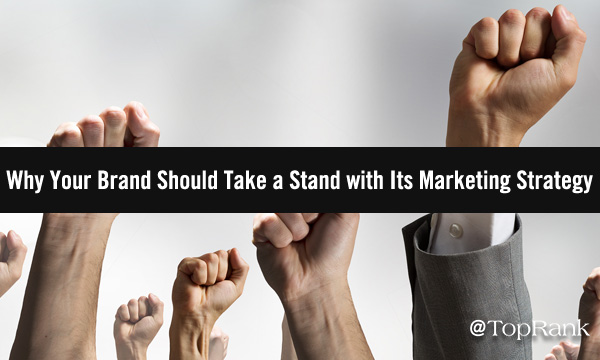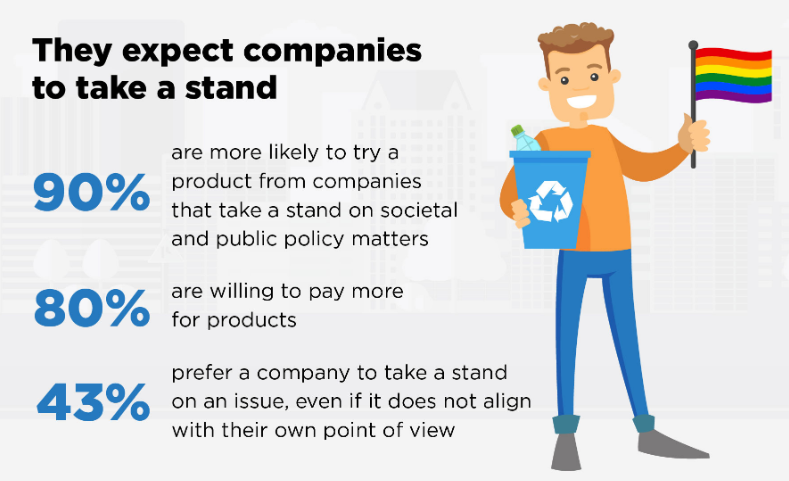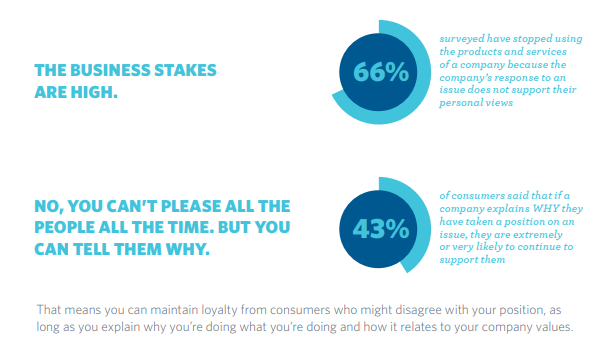Posted by: Online Marketing Blog – TopRank®
Posted on: 9/16/2019

 Earlier this year, Salesforce made waves by announcing a policy that compelled retailers to either stop selling military-style rifles and certain accessories, or stop using its popular e-commerce software.
For a massive brand like this to take such an emphatic stand on a divisive social issue would’ve been unthinkable not so long ago. But in today’s world at large, and consequently in the business and marketing environments, it’s becoming more common. This owes to a variety of factors, ranging from generational changes among consumers to a growing need to differentiate.
But, like so many other trends and strategies we see emerging in digital marketing, I think it mostly comes back to one overarching thing: the trust factor.
In this installment of our Trust Factors series, we’ll explore why and how brands and corporations can take a stand on important issues, building trust and rapport with customers and potential buyers in the process.
Earlier this year, Salesforce made waves by announcing a policy that compelled retailers to either stop selling military-style rifles and certain accessories, or stop using its popular e-commerce software.
For a massive brand like this to take such an emphatic stand on a divisive social issue would’ve been unthinkable not so long ago. But in today’s world at large, and consequently in the business and marketing environments, it’s becoming more common. This owes to a variety of factors, ranging from generational changes among consumers to a growing need to differentiate.
But, like so many other trends and strategies we see emerging in digital marketing, I think it mostly comes back to one overarching thing: the trust factor.
In this installment of our Trust Factors series, we’ll explore why and how brands and corporations can take a stand on important issues, building trust and rapport with customers and potential buyers in the process.
The Business Case for Bold Stances
Executives from Salesforce might suggest that it made such a bold and provocative move simply because they felt it was the right thing to do. (CEO Marc Benioff, for instance, has been outspoken about gun control and specifically his opposition to the AR-15 rifle.) But of course, one of the 10 largest software companies in the world isn’t making these kinds of decisions without a considerable business case behind them. Like many other modern companies, Salesforce is taking the lead in a movement that feels inevitable. As millennials come to account for an increasingly large portion of the customer population, corporate social responsibility weighs more and more heavily on marketing strategies everywhere. A few data points to think about:- Research last year by FleishmanHillard found that 61% of survey respondents believe it’s important for companies to express their views, whether or not the person agrees with them.
- Per the same study, 66% say they have stopped using the products and services of a company because the company’s response to an issue does not support their personal view.
- The latest global Earned Brand Report from Edelman found that 64% of people are now “belief-driven buyers,” meaning they will choose, switch, avoid or boycott a brand based on its stand on societal issues.
- MWWPR categorizes 35% of the adult population in the U.S. as “corpsumers,” up by two percentage points from the prior year. The term describes "a brand activist who considers a company's values, actions and reputation to be just as important as their product or service."
- Corpsumers say they’re 90% more likely to patronize companies that take a stand on social and public policy matters, and 80% say they’ll even pay more for products from such brands.

(Source)
What Does It Mean to Take a Stand as a Brand?
Admittedly, the phrase is somewhat ambiguous. So let’s clear something up right now: taking a stand doesn’t necessarily mean your company needs to speak out on touchy political issues. When Dave Gerhart, Vice President of Marketing for Drift, gave a talk at B2BSMX last month outlining his 10 commandments for modern marketing, taking a stand was among the directives he implored. Gerhart pointed to Salesforce’s gun gambit as one precedent, but also called out a less controversial example: his own company’s crusade against the lead form. I think this serves as a great case in point. Lead forms aren’t a hot-button societal issue that’s going to rile people up, necessarily, but they’ve been a subject of annoyance on the consumer side for years. Drift’s decision to do away with them completely did entail some risk (to back up their stance, they had to commit to not using this proven, mainstream method for generating actionable leads) but made a big impression within their industry. Now, it’s a rallying cry for their brand. From my view, these are the trust-building ingredients, which both the Salesforce and Drift examples cover:- It has to matter to your customers
- It has to be relevant to your industry or niche
- It has to entail some sort of risk or chance-taking on behalf of the brand
Mitigating the Risks of Taking a Stand
The potential downside of taking a controversial stand is obvious enough: “What if we piss off a bunch of our customers and our bottom line takes a hit?” Repelling certain customers is inherent to any bold stance, but obviously you’ll want the upside (i.e., affinity and loyalty built with current customers, plus positive attention drawing in new customers) to strongly outdistance the downside (i.e., existing or potential customers defecting because they disagree). Here are some things to think about on this front.Know Your Audience and Employees
It’s always vital for marketers to have a deep understanding of the people they serve, and in this case it’s especially key. You’ll want to have a comprehensive grasp of the priorities and attitudes of people in your target audience to ensure that a majority will agree with — or at least tolerate — your positioning. Region, age, and other demographic factors can help you reach corollary conclusions. For example, our clients at Antea Group are adamant about the dangers of climate change. In certain circumstances this could (sadly) be a provocative and alienating message, but Antea Group serves leaders and companies focusing on sustainability, who widely recognize the reality and urgency of climate change. Not only that, but Antea Group also employs people who align with this vision, so embracing its importance both externally and internally leads to heightened engagement and award-winning culture. As another example, retailer Patagonia shook things up in late 2017 when it proclaimed on social media “The President Stole Your Land” after the Trump administration moved to reduce a pair of national monuments. In a way, this is potentially off-putting for the sizable chunk of its customer base that supports Trump, but given that Patagonia serves (and employs) an outdoorsy audience, the sentiment resonated and the company is thriving.Know Your Industry and Competition
On the surface, Salesforce taking a public stand on gun control seems quite audacious. The Washington Post notes that retailers like Camping World, which figured to be affected by the new policy, are major customers for the platform. What if this drives them elsewhere? However, peer companies like Amazon and Shopify have their own gun restriction policies in place, so the move from Salesforce isn’t as “out there” as one might think. When you see your industry as a whole moving in a certain direction, it’s beneficial to get out front and position yourself as a leader rather than a follower.Actions Speak Louder
Empty words are destined to backfire. Taking a stand is meaningless if you can’t back it up. Analysts warn that “goodwashing” is the new form of “greenwashing,” a term that refers to companies talking a big game on eco-friendly initiatives but failing to follow up with meaningful actions. According to MWWPR’s chief strategy officer Careen Winters (via AdWeek): “Companies that attempt to take a stand on issues but don’t really put their money where their mouth is, or what they are doing is not aligned with their track record and core values, will find themselves in a position where the corpsumers don’t believe them. Fifty-nine percent of corpsumers say they are skeptical about a brand’s motives for taking a stand on policy issues.”Be Transparent and Authentic
One interesting aspect of the aforementioned FleishmanHillard study: 66% of respondents say they’ve stopped using the products and services of a company because the company’s response to an issue did not support their personal views; however another 43% say that if company explains WHY they have taken a position on an issue, the customer is extremely likely to keep supporting them.
(Source)
In other words, transparency is essential. If you fully explain the “why” behind a particular brand stance, you can score trust-building benefits with both those who do and do not agree.Where We Stand at TopRank
At TopRank Marketing, we have a few stances that we openly advocate. One is gender equality; our CEO Lee Odden noticed many "top marketers" lists and editorial collaborations were crowded with men, so he (and we) have made it a point to highlight many of the women leading the way in our industry, both through our content projects and Lee's annual Women Who Rock Digital Marketing lists (10 years running!). Another is our commitment to serving a deeper purpose as a business. Of course we want to help our clients reach their business goals, but we also love working with virtuous brands that are improving the communities around them. We strive to also do so ourselves through frequent volunteering, donations to causes, and charitable team outings. These include packing food for the hungry, renovating yards for the homeless, and our upcoming Walk for Alzheimer's participation.The Worst Stand You Can Take is Standing Still
Trust in marketing is growing more vital each day. It’s not enough to offer a great product or excellent customer service. Increasingly, customers want to do business with companies they like, trust, and align with. Those brands that sit on the sidelines regarding important issues are coming under greater scrutiny. Meanwhile, those with the guile to take bold but strategically sound stands are being rewarded. To learn more about navigating these waters without diminishing trust or eroding your brand’s credibility, take a look at our post on avoiding trust fractures through authenticity, purpose-driven decision-making, and a big-picture mindset. Or check out these other entries in our “Trust Factors” series:- The B2B Marketing Funnel is Dead: Say Hello to the Trust Funnel
- Trust Factors: The (In)Credible Impact of B2B Influencer Marketing
- Trust Factors: How Best Answer Content Fuels Brand Credibility
- Tip of the Iceberg: A Story of Trust in Marketing as Told by Statistics
- Be Like Honest Abe: How Content Marketers Can Build Trust Through Storytelling
The post Trust Factors: Why Your Brand Should Take a Stand with Its Marketing Strategy appeared first on Online Marketing Blog - TopRank®.
BACK TO ISSUE

